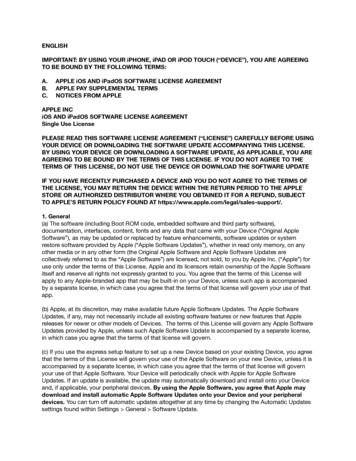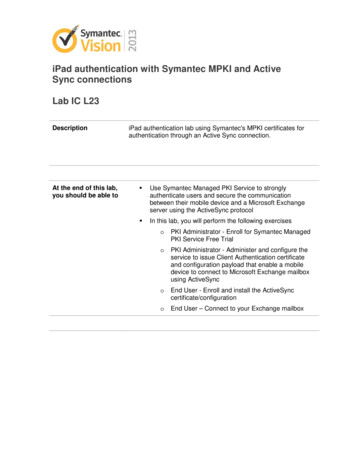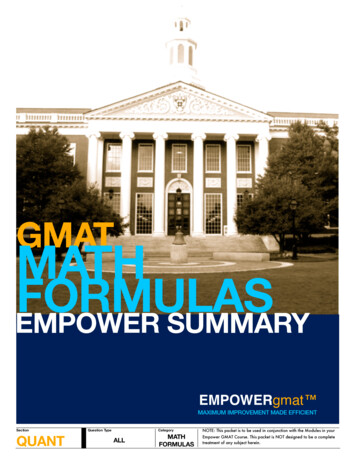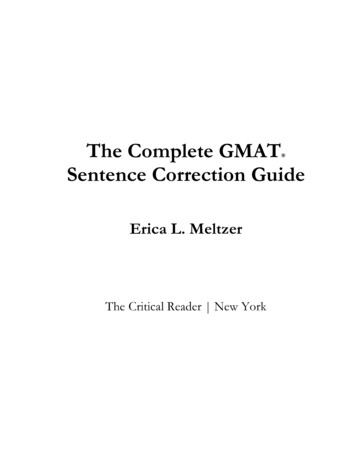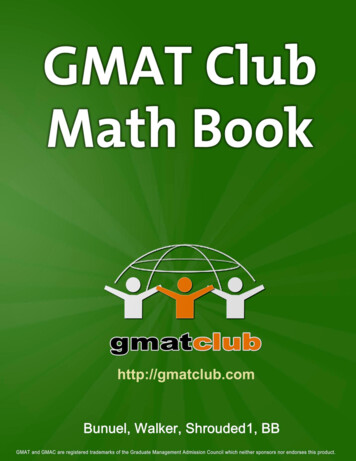
Transcription
For the latest version of the GMAT .BUI #Pok,please visit: http://gmatclub.com/NBUICPPLGMAT Club’s Other Resources:GMAT Club CAT TestsGMAT Toolkit iPad Appgmatclub.com/testsgmatclub.com/iPhoneThe Verbal InitiativeGMAT Course & AdmissionsConsultant Reviewsgmatclub.com/verbalgmatclub.com/reviewsGMAT Club Math clubforum
Table of ContentsNumber Theory . 3INTEGERS. 3IRRATIONAL NUMBERS . 3POSITIVE AND NEGATIVE NUMBERS . 4FRACTIONS . 9EXPONENTS . 12LAST DIGIT OF A PRODUCT . 13LAST DIGIT OF A POWER . 13ROOTS . 14PERCENT . 15Absolute Value . 17Factorials . 21Algebra . 23Remainders . 27Word Problems Overview . 33Distance/Speed/Time Word Problems . 37Work Word Problems . 45Advanced Overlapping Sets Problems. 49Polygons . 66Circles . 72Coordinate Geometry . 81Standard Deviation . 101Probability . 105Combinations & Permutations . 1113‐D Geometries. 118‐2‐GMAT Club Math Bookpart of GMAT ToolKit iPhone App
Number TheoryDefinitionNumber Theory is concerned with the properties of numbers in general, and in particular integers.As this is a huge issue we decided to divide it into smaller topics. Below is the list of Number Theory topics.GMAT Number TypesGMAT is dealing only with Real Numbers: Integers, Fractions and Irrational Numbers.INTEGERSDefinitionIntegers are defined as: all negative natural numbersnumbers, zero, and positive natural.Note that integers do not include decimals or fractions ‐ just whole numbers.Even and Odd NumbersAn even number is an integer that is "evenly divisible" by 2, i.e., divisible by 2 without a remainder.An even number is an integer of the form, whereis an integer.An odd number is an integer that is not evenly divisible by 2.An odd number is an integer of the form, whereis an integer.Zero is an even number.Addition / Subtraction:even /‐ even even;even /‐ odd odd;odd /‐ odd even.Multiplication:even * even even;even * odd even;odd * odd odd.Division of two integers can result into an even/odd integer or a fraction.IRRATIONAL NUMBERSFractions (also known as rational numbers) can be written as terminating (ending) or repeating decimals (such as0.5, 0.76, or 0.333333.). On the other hand, all those numbers that can be written as non‐terminating, non‐repeating decimals are non‐rational, so they are called the "irrationals". Examples would be("the square rootof two") or the number pi ( 3.14159., from geometry). The rational and the irrationals are two totallyseparate number types: there is no overlap.Putting these two major classifications, the rational numbers and the irrational, together in one set gives you the"real" numbers.‐3‐GMAT Club Math Bookpart of GMAT ToolKit iPhone App
POSITIVE AND NEGATIVE NUMBERSA positive number is a real number that is greater than zero.A negative number is a real number that is smaller than zero.Zero is not positive, nor negative.Multiplication:positive * positive positivepositive * negative negativenegative * negative positiveDivision:positive / positive positivepositive / negative negativenegative / negative positivePrime NumbersA Prime number is a natural number with exactly two distinct natural number divisors: 1 and itself. Otherwise anumber is called a composite number. Therefore, 1 is not a prime, since it only has one divisor, namely 1. Anumberis prime if it cannot be written as a product of two factors and , both of which are greater than1: n ab. The first twenty‐six prime numbers are:2, 3, 5, 7, 11, 13, 17, 19, 23, 29, 31, 37, 41, 43, 47, 53, 59, 61, 67, 71, 73, 79, 83, 89, 97, 101 Note: only positive numbers can be primes. There are infinitely many prime numbers. The only even prime number is 2, since any larger even number is divisible by 2. Also 2 is the smallest prime. All prime numbers except 2 and 5 end in 1, 3, 7 or 9, since numbers ending in 0, 2, 4, 6 or 8 are multiples of 2and numbers ending in 0 or 5 are multiples of 5. Similarly, all prime numbers above 3 are of theformor, because all other numbers are divisible by 2 or 3. Any nonzero natural numbercan be factored into primes, written as a product of primes or powers ofprimes. Moreover, this factorization is unique except for a possible reordering of the factors. Prime factorization: every positive integer greater than 1 can be written as a product of one or more primeintegers in a way which is unique. For instance integerwith three unique prime factors , , and can beexpressed asExample:, where,, andare powers of,, and, respectively and are. Verifying the primality (checking whether the number is a prime) of a given numbercan be done by trialdivision, that is to say dividingby all integer numbers smaller than, thereby checking whetheris amultiple of.Example: Verifying the primality of:is little less than, from integers from to,isdivisible by , henceis not prime. Ifis a positive integer greater than 1, then there is always a prime numberwith.FactorsA divisor of an integer, also called a factor ofremainder. In general, it is saidis a factor ofintegersuch that., is an integer which evenly divideswithout leaving a, for non‐zero integersand, if there exists an‐4‐GMAT Club Math Bookpart of GMAT ToolKit iPhone App
1 (and ‐1) are divisors of every integer. Every integer is a divisor of itself. Every integer is a divisor of 0, except, by convention, 0 itself. Numbers divisible by 2 are called even and numbers not divisible by 2 are called odd. A positive divisor of n which is different from n is called a proper divisor. An integer n 1 whose only proper divisor is 1 is called a prime number. Equivalently, one would say that aprime number is one which has exactly two factors: 1 and itself. Any positive divisor of n is a product of prime divisors of n raised to some power. If a number equals the sum of its proper divisors, it is said to be a perfect number.Example: The proper divisors of 6 are 1, 2, and 3: 1 2 3 6, hence 6 is a perfect number.There are some elementary rules: Ifofis a factor ofandis a factor offor all integersand, thenis a factor ofis a factor ofandis a factor of, thenis a factor of Ifis a factor ofandis a factor of, thenor Ifis a factor of, andis a factor ofthen., then a is a factor ofis a prime number andis a factor. If If. In fact,.is a factor oforis a factor of.Finding the Number of Factors of an IntegerFirst make prime factorization of an integerofand, , and are their powers.The number of factors ofand n itself., where,, andwill be expressed by the formulaare prime factors. NOTE: this will include 1Example: Finding the number of all factors of 450:Total number of factors of 450 including 1 and 450 itself isfactors.Finding the Sum of the Factors of an IntegerFirst make prime factorization of an integerofand, , and are their powers.The sum of factors of, where,, andare prime factorswill be expressed by the formula:Example: Finding the sum of all factors of 450:The sum of all factors of 450 is‐5‐GMAT Club Math Bookpart of GMAT ToolKit iPhone App
Greatest Common Factor (Divisor) ‐ GCF (GCD)The greatest common divisor (GCD), also known as the greatest common factor (GCF), or highest common factor(HCF), of two or more non‐zero integers, is the largest positive integer that divides the numbers without aremainder.To find the GCF, you will need to do prime‐factorization. Then, multiply the common factors (pick the lowestpower of the common factors). Every common divisor of a and b is a divisor of GCD (a, b). a*b GCD(a, b)*lcm(a, b)Lowest Common Multiple ‐ LCMThe lowest common multiple or lowest common multiple (lcm) or smallest common multiple of two integers a andb is the smallest positive integer that is a multiple both of a and of b. Since it is a multiple, it can be divided by aand b without a remainder. If either a or b is 0, so that there is no such positive integer, then lcm(a, b) is definedto be zero.To find the LCM, you will need to do prime‐factorization. Then multiply all the factors (pick the highest power ofthe common factors).Perfect SquareA perfect square, is an integer that can be written as the square of some other integer. For example 16 4 2, is anperfect square.There are some tips about the perfect square: The number of distinct factors of a perfect square is ALWAYS ODD. The sum of distinct factors of a perfect square is ALWAYS ODD. A perfect square ALWAYS has an ODD number of Odd‐factors, and EVEN number of Even‐factors. Perfect square always has even number of powers of prime factors.Divisibility Rules2 ‐ If the last digit is even, the number is divisible by 2.3 ‐ If the sum of the digits is divisible by 3, the number is also.4 ‐ If the last two digits form a number divisible by 4, the number is also.5 ‐ If the last digit is a 5 or a 0, the number is divisible by 5.6 ‐ If the number is divisible by both 3 and 2, it is also divisible by 6.7 ‐ Take the last digit, double it, and subtract it from the rest of the number, if the answer is divisible by 7(including 0), then the number is divisible by 7.8 ‐ If the last three digits of a number are divisible by 8, then so is the whole number.9 ‐ If the sum of the digits is divisible by 9, so is the number.10 ‐ If the number ends in 0, it is divisible by 10.11 ‐ If you sum every second digit and then subtract all other digits and the answer is: 0, or is divisible by 11, thenthe number is divisible by 11.Example: to see whether 9,488,699 is divisible by 11, sum every second digit: 4 8 9 21, then subtract the sum of‐6‐GMAT Club Math Bookpart of GMAT ToolKit iPhone App
other digits: 21‐(9 8 6 9) ‐11, ‐11 is divisible by 11, hence 9,488,699 is divisible by 11.12 ‐ If the number is divisible by both 3 and 4, it is also divisible by 12.25 ‐ Numbers ending with 00, 25, 50, or 75 represent numbers divisible by 25.FactorialsFactorial of a positive integerFor instance, denoted by., is the product of all positive integers less than or equal to n. Note: 0! 1. Note: factorial of negative numbers is undefined.Trailing zeros:Trailing zeros are a sequence of 0's in the decimal representation (or more generally, in any positionalrepresentation) of a number, after which no other digits follow.125000 has 3 trailing zeros;The number of trailing zeros in the decimal representation of n!, the factorial of a non‐negative integerbe determined with this formula:, where k must be chosen such that, can.It's easier if you look at an example:How many zeros are in the end (after which no other digits follow) of(denominator must be less than 32,?is less)Hence, there are 7 zeros in the end of 32!The formula actually counts the number of factors 5 in n!, but since there are at least as many factors 2, this isequivalent to the number of factors 10, each of which gives one more trailing zero.Finding the number of powers of a prime number, in the.The formula is:. tillWhat is the power of 2 in 25!?Finding the power of non‐prime in n!:How many powers of 900 are in 50!Make the prime factorization of the number:in the n!., then find the powers of these prime numbersFind the power of 2: Find the power of 3:‐7‐GMAT Club Math Bookpart of GMAT ToolKit iPhone App
Find the power of 5: We need all the prime {2,3,5} to be represented twice in 900, 5 can provide us with only 6 pairs, thus there is 900in the power of 6 in 50!.Consecutive IntegersConsecutive integers are integers that follow one another, without skipping any integers. 7, 8, 9, and ‐2, ‐1, 0, 1,are consecutive integers. Sum ofconsecutive integers equals the mean multiplied by the number of terms,integers,terms), so the sum equals to. Given consecutive, (mean equals to the average of the first and last. If n is odd, the sum of consecutive integers is always divisible by n. Given, wehaveconsecutive integers. The sum of 9 10 11 30, therefore, is divisible by 3. If n is even, the sum of consecutive integers is never divisible by n. Given, wehaveconsecutive integers. The sum of 9 10 11 12 42, therefore, is not divis
GMAT Club Math Book part of GMAT ToolKit iPhone App Number Theory Definition Number Theory is concerned with the properties of numbers in general, and in particular integers. As this is a huge issue we decided to divide it into smaller topics. Below is the list of Number Theory topics. GMAT Number Types



